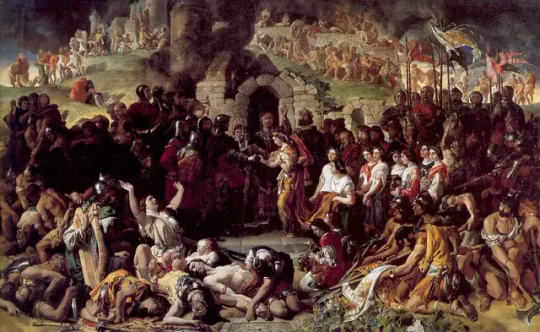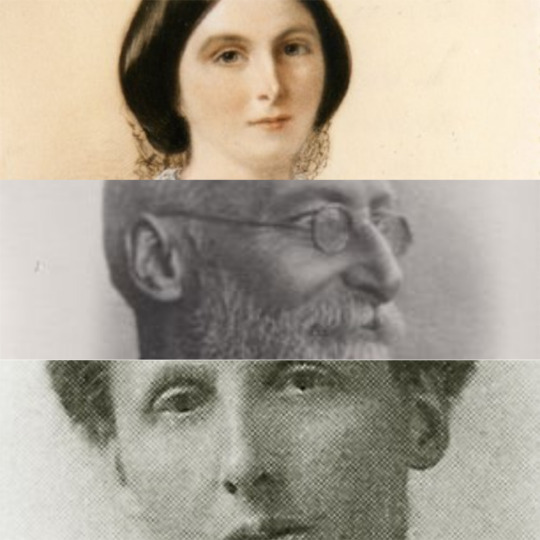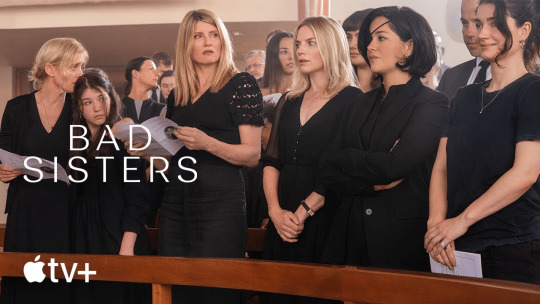#Eva of Leinster
Explore tagged Tumblr posts
Text
#OTD in 1170 – Richard de Clare (Strongbow) marries Aoife Ní MacMurrough and sets a precedent for Norman rule in Ireland.
Aoife Ní MacMurrough, also known by later historians as Eva of Leinster, was a noble, princess of Leinster and countess of Pembroke. She was the daughter of Dermot MacMurrough, King of Leinster and his second wife, Mor O’Toole, a relation of St Lawrence O’Toole. Following the Norman invasion of Ireland that her father had requested, she married Richard de Clare, 2nd Earl of Pembroke, better known…

View On WordPress
#Aoife Ní MacMurrough#Dermot MacMurrough#Eva of Leinster#Ireland#Marriage#Norman Invasion of Ireland#Red Eva#Richard de Clare#Strongbow
7 notes
·
View notes
Text

Aoife MacMurrough (c. 1153 – c. 1188), also known as Eva of Leinster or Red Eva, was an Irish noblewoman. The daughter of King of Leinster Dermot MacMurrough, her marriage to Anglo-Norman nobleman Richard "Strongbow" de Clare on 25 August 1170 is considered a pivotal moment in the Anglo-Norman invasion of Ireland.
#Aoife MacMurrough#Eva of Leinster#Red Eva#Uí Ceinnselaig Dynasty#House MacMurrough-Kavanagh#women in history#xii century
0 notes
Text









The Irish Princess and her dynastic marriage to a Norman that helped shape Europe. Aoife, Princess of Leinster -> Catherine, The Princess of Wales. The Princess of Wales is Aoife, Princess of Leinster and Richard de Clare, Earl of Pembroke 26th Great-Granddaughter via her paternal grandfather’s line.
** Aoife or Eva, Princess of Leinster, played a pivotal role in the history of Ireland and the Norman expansion. She was the daughter of Diarmaid MacMurrough, King of Leinster, who sought the help of the Normans to secure his throne and defeat his enemies. As part of this alliance, Aoife married the Norman leader Richard de Clare, known as ‘Strongbow,’ on 25 August 1170. This marriage marked the arrival of the Normans in Ireland, just 104 years after their conquest of England by William the Conqueror.
Through their daughter, Isabelle de Clare, The 4th Countess of Pembroke, the union of Aoife and Strongbow forged a lineage that would shape the future of European nobility. Isabelle became an ancestor of nearly every reigning monarch across Europe. Within a few generations, her descendants included much of the European aristocracy, including all the Kings of Scotland since Robert the Bruce (1274–1329) and every monarch of England, Great Britain, and the United Kingdom since Henry IV (1367–1413).
Family Line
Aoife MacMurrough, Princess of Leinster and Richard de Clare, 2nd Earl of Pembroke. Painting of their wedding, depicting the political and cultural consequences.
Isabelle de Clare 4th Countess of Pembroke m. William Marshall 1st Earl of Pembroke.
Eve Marshall m William de Briouze, born Pembroke Castle.
Eve de Briouze m. William de Cauntelo, Coat of Arms
Millicent de Cauntelo m. Eon la Zouche, Coat of Arms
Eva la Zouche m. Maurice de Berkeley, 2nd Lord Berkeley, buried St Mary's Church, Portbury.
Thomas de Berkeley, 3rd Lord Berkeley m. Catherine Clivedon
Sir John Berkeley m. Elizabeth Betteshorne, burial location.
Eleanor Berkeley m. Sir Richard Poynings, burial tomb.
Eleanor de Poynings m. Henry Percy, 3rd Earl of Northumberland
Lady Margaret Percy m. Sir William Gascoigne
Anne Gascoigne m. Sir Thomas Fairfax - Gawthorpe Hall, family seat.
William Fairfax m. Anne Baker - Gilling Castle, family seat.
John Fairfax m. Mary Birch - Master of the Great Hospital at Norwich, Norfolk
Rev. Benjamin Fairfax m. Sarah Galliard - Preacher at Rumburgh, Suffolk.
Benjamin Fairfax m. Bridget Stringer - died in Halesworth, Suffolk.
Sarah Fairfax m. Rev. John Meadows - died in Ousedon, Suffolk.
Philip Meadows m. Margaret Hall
Sarah Meadows m. Dr. David Martineau
Thomas Martineau m. Elizabeth Rankin - buried at Rosary Cemetery, Norwich.
Elizabeth Martineau m. Dr. Thomas Michael Greenhow - died in Newcastle upon Tyne, Northumberland.
Frances Elizabeth Greenhow m. Francis Lupton
Francis Martineau Lupton m. Harriet Davis
Olive Lupton m. Richard Middleton
Peter Middleton m. Valerie Glassborow
Michael Middleton m. Carole Goldsmith
Catherine Middleton m. Prince William of Wales
*Catherine is also a descendant of Aoife via her mother Caroles maternal line.
#ktd#brf#british royal family#kate middleton#princess of wales#british royal fandom#History#history lesson#cultures#european history#women in history#strongbow#medieval art#historical#middle ages#medieval core#ireland#irish history#normans#Aoife#princess of Leinster
25 notes
·
View notes
Photo

Ireland’s Vanishing Triangle
On March 26, 1993, 26-year-old native New Yorker Annie McCarrick went missing from Sandymount. She was last seen outside a post office in Enniskerry. Her parents arrived after being contacted by their daughter’s friends. The parents stayed in Ireland for six months while searching unsuccessfully for their daughter.
On July 25, 1993, 39-year-old Eva Brennan left her parents’ house in Rathgar but never made it back to her apartment. After two days of not hearing from his daughter, her father went to investigate. Inside Eva’s apartment, he found the jacket she’d been wearing the day she disappeared. Eva was never seen again.
On January 3, 1994, 22-year-old Imelda Keenan told her boyfriend that she was going to the post office. She left their apartment in Waterford City at 1:30 PM. The local doctor’s secretary was the last person to see Keenan as she crossed a road in town and seemingly vanished into thin air.
On November 9, 1995, 21-year-old Josephine Dollard was spotted using a pay phone in the Moone area of Kildare. After she ended the call, she was seen getting into a car with an unknown person. Dollard never made it back home.
On August 23, 1996, 25-year-old Fiona Pender vanished after leaving her apartment in Tullamore. On February 13, 1997, 17-year-old Ciara Breen disappeared from her home in Dundalk. On February 8, 1998, 19-year-old Fiona Sinnott went missing after leaving a pub in Broadway. On July 28, 1998, 18-year-old Deirdre Jacob went missing mere meters from her parents’ home.
None of these young women have ever been found.
The tie that binds them together? They all disappeared in what has come to be known as Ireland’s Vanishing Triangle within the boundaries of Leinster. Police decided that the missing women were most likely murdered and focused their investigation on convicted rapist Larry Murphy. He was charged with an unrelated rape and attempted murder case in 2000.
With Murphy in prison, the vanishings abruptly stopped, giving authorities even more reason to suspect him. Unfortunately, a lack of evidence and staunch denials on Murphy’s part mean that he was never charged for any of the disappearances. The fate of those who vanished remains unknown.
24 notes
·
View notes
Text
WHERE IS BAD SISTERS FILMED? TV SHOW FILMING LOCATIONS

Based on the Flemish series ‘Clan’ by Malin-Sarah Gozin, Apple TV+’s ‘Bad Sisters�� is a dark comedy thriller series created by Sharon Horgan that follows the five Garvey sisters — Grace, Ursula, Eva, Bibi, and Becka. When their parents die prematurely and unexpectedly, the sisters find themselves in a complicated situation that puts their bond to the test. After the family tragedy, the Garvey sisters must get over their differences and try to fulfill the promises they made to always look after one another. Meanwhile, the authorities attempt to solve the mystery behind the death. With dark humor always lurking on the tip of the characters’ tongues, it lightens up the thrilling aspects of the series quite significantly. Nevertheless, the suspenseful narrative keeps the viewers on the edge of their seats through each episode. In addition, the picturesque and interesting locations in the backdrop make one curious about the actual filming sites of the series. If you are one such curious soul, allow us to rid you of your curiosities by filling you in on all the details regarding the same! BAD SISTERS FILMING LOCATIONS ‘Bad Sisters’ is filmed in the Republic of Ireland, Northern Ireland, and England, specifically in County Dublin, Belfast, and London. The principal photography for the inaugural iteration of the dark comedy series took place in 2021 and wrapped up in September of the same year. Since the story is based in Dublin and London, it makes sense why the filming unit chooses to record a majority of the series on location. Not only does it add an element of authenticity, but it also gives viewers an immersive viewing experience. So, let’s get to know about all the specific locations that appear in the Apple TV+ series! COUNTY DUBLIN, REPUBLIC OF IRELAND Major portions of ‘Bad Sisters’ are lensed in County Dublin, a county in the province of Leinster. During the filming schedule of the debut season, particularly in August 2021, the production team was spotted taping several pivotal sequences in and around Forty Foot, a promontory on the southern tip of Dublin Bay at Sandycove. They even shot some water scenes at the Irish Sea surrounding the promontory. Furthermore, the suburban village of Howth and the coastal settlement of Malahide in Fingal serve as prominent production locations for the thriller series. Apart from ‘Bad Sisters,’ you may spot some parts of County Dublin in other movies and TV shows, such as ‘Braveheart,’ ‘Mary Shelley,’ ‘Normal People,’ and ‘Penny Dreadful.’ BELFAST, NORTHERN IRELAND As per reports, the cast and crew members of ‘Bad Sisters’ also utilize the locales of Belfast, the capital and largest city of Northern Ireland, for the production of the series. Located on the banks of the River Lagan on the east coast, Belfast is known to be one of the most visited cities in all of the United Kingdom. The city is home to several beautiful parks and gardens, including Botanic Gardens and Sir Thomas and Lady Dixon Park, to name a couple. LONDON, ENGLAND A few additional portions of the dark comedy series are also taped in London, the capital and largest city of England and the United Kingdom. Situated in southeast England, London is considered one of the major global cities as it is highly influential in several industries, such as art, fashion, education, entertainment, healthcare, tourism, commerce and finance, science and technology, media, transport, and communications. Over the years, the capital has served as a prominent production location for different kinds of filming projects, including ‘Jurassic World Dominion,’ ‘The Batman,’ ‘Ted Lasso,’ and ‘Industry.’ Read More: Bad Sisters – Season 1 Episode 2 « Explode a Man » Recap & Review Read the full article
6 notes
·
View notes
Text
Marpha / マーファ
Marpha is the name of the Verdanian castle ruled by Prince Gandolf in Fire Emblem: Genealogy of the Holy War. Marpha is the name of the apple capital of Nepal. However, I don't believe that to be the intent behind this name.
The Japanese name of Marpha is マーファ (rōmaji: māfa). I believe this to be a corruption of マーフィ (rōmaji: māfi), the Japanese rendering of the name Murphy. Murphy is an anglicization of the Irish surnames Ó/mac Murchadha and Ó/mac Murchadh, meaning "(descendant of) a sea warrior".
I believe the name is intended to reference Diarmaid mac Murchadha, a king of Leinster who was deposed by the High King for the abduction of Derbforgaill, wife of king Tigernán Ua Ruairc. Exiled, Mac Muchadha fled to England to request aid from King Henry II. He gained support from some of the Anglo-Norman nobles and invaded Ireland, marking the beginning of the Norman conquest of Ireland. All of this is very appropriate regarding Marpha's ruler and the conflict between Verdane and Grannvale: Gandolf abducted Edain like Mac Muchadha did Derbforgaill, which brought about conflict with a neighboring nation.
I do have to recognize some possible issues regarding my theory. First of all, Diarmaid mac Murchadha is often anglicized as Dermot MacMurrough, using an alternative anglicization than Murphy. There is also the presence of a character in Jugdral's second game, Thracia 776, named マーフィ, and is thus localized in the current fan-translations as Murphy. This could suggest that Marpha is intended as another name. However, I do not feel this would outright reject my speculation, as in Genealogy of the Holy War itself are the names エヴァ(rōmaji: eva) and オイフェ (rōmaji: oifei) — both of which are referencing the Irish name Aoife.
If anyone would like to suggest alternative possibilities of what Marpha's name is supposed to be, please contact me. I'm always happy to discuss, and will make edits when needed.
1 note
·
View note
Text
#OTD in 1170 – Richard de Clare (Strongbow) marries Aoife Ní MacMurrough and sets a precedent for Norman rule in Ireland.
#OTD in 1170 – Richard de Clare (Strongbow) marries Aoife Ní MacMurrough and sets a precedent for Norman rule in Ireland.
Aoife Ní MacMurrough, also known by later historians as Eva of Leinster, was a noble, princess of Leinster and countess of Pembroke. She was the daughter of Dermot MacMurrough, King of Leinster and his second wife, Mor O’Toole, a relation of St Lawrence O’Toole. Following the Norman invasion of Ireland that her father had requested, she married Richard de Clare, 2nd Earl of Pembroke, better known…

View On WordPress
#Aoife Ní MacMurrough#Dermot MacMurrough#Eva of Leinster#Ireland#Marriage#Norman Invasion of Ireland#Red Eva#Richard de Clare#Strongbow
7 notes
·
View notes
Text
#OTD in 1170 – Richard de Clare (Strongbow) marries Aoife Ní MacMurrough and sets a precedent for Norman rule in Ireland.
#OTD in 1170 – Richard de Clare (Strongbow) marries Aoife Ní MacMurrough and sets a precedent for Norman rule in Ireland.
Aoife Ní MacMurrough, also known by later historians as Eva of Leinster, was a noble, princess of Leinster and countess of Pembroke. She was the daughter of Dermot MacMurrough, King of Leinster and his second wife, Mor O’Toole, a relation of St Lawrence O’Toole. Following the Norman invasion of Ireland that her father had requested, she married Richard de Clare, 2nd Earl of Pembroke, better known…

View On WordPress
#Aoife Ní MacMurrough#Dermot MacMurrough#Eva of Leinster#Ireland#Marriage#Norman Invasion of Ireland#Red Eva#Richard de Clare#Strongbow
3 notes
·
View notes
Text
#OTD in 1170 – Richard de Clare (Strongbow) marries Aoife Ní MacMurrough and sets a precedent for Norman rule in Ireland.
#OTD in 1170 – Richard de Clare (Strongbow) marries Aoife Ní MacMurrough and sets a precedent for Norman rule in Ireland.
Aoife Ní MacMurrough, also known by later historians as Eva of Leinster, was a noble, princess of Leinster and countess of Pembroke. She was the daughter of Dermot MacMurrough, King of Leinster and his second wife, Mor O’Toole, a relation of St Lawrence O’Toole.
Following the Norman invasion of Ireland that her father had requested, she married Richard de Clare, 2nd Earl of Pembroke, better known…
View On WordPress
#Aoife Ní MacMurrough#Dermot MacMurrough#Eva of Leinster#Ireland#Marriage#Norman Invasion of Ireland#Red Eva#Richard de Clare#Strongbow
1 note
·
View note
Text
#OTD in 1170 – Richard de Clare (Strongbow) marries Aoife Ní MacMurrough and sets a precedent for Norman rule in Ireland.
#OTD in 1170 – Richard de Clare (Strongbow) marries Aoife Ní MacMurrough and sets a precedent for Norman rule in Ireland.

Aoife Ní MacMurrough, also known by later historians as Eva of Leinster, was a noble, princess of Leinster and countess of Pembroke. She was the daughter of Dermot MacMurrough, King of Leinster and his second wife, Mor O’Toole, a relation of St Lawrence O’Toole.
Following the Norman invasion of Ireland that her father had requested, she married Richard de Clare, 2nd Earl of Pembroke, better known…
View On WordPress
#Aoife Ní MacMurrough#Dermot MacMurrough#Eva of Leinster#Ireland#Marriage#Norman Invasion of Ireland#Red Eva#Richard de Clare#Strongbow
5 notes
·
View notes
Text
#OTD in 1170 – Richard de Clare (Strongbow) marries Aoife Ní MacMurrough and sets a precedent for Norman rule in Ireland.
#OTD in 1170 – Richard de Clare (Strongbow) marries Aoife Ní MacMurrough and sets a precedent for Norman rule in Ireland.
Aoife Ní MacMurrough, also known by later historians as Eva of Leinster, was a noble, princess of Leinster and countess of Pembroke. She was the daughter of Dermot MacMurrough, King of Leinster and his second wife, Mor O’Toole, a relation of St Lawrence O’Toole.
Following the Norman invasion of Ireland that her father had requested, she married Richard de Clare, 2nd Earl of Pembroke, better known…
View On WordPress
#Aoife Ní MacMurrough#Dermot MacMurrough#Eva of Leinster#Ireland#Marriage#Norman Invasion of Ireland#Red Eva#Richard de Clare#Strongbow
5 notes
·
View notes